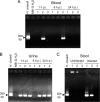Identification of and screening for human Helicobacter cinaedi infections and carriers via nested PCR
- PMID: 23015666
- PMCID: PMC3502999
- DOI: 10.1128/JCM.01622-12
Identification of and screening for human Helicobacter cinaedi infections and carriers via nested PCR
Abstract
Helicobacter cinaedi is the most frequently reported enterohepatic Helicobacter species isolated from humans. Earlier research suggested that certain patients with H. cinaedi infection may remain undiagnosed or incorrectly diagnosed because of difficulties in detecting the bacteria by conventional culture methods. Here, we report a nested PCR assay that rapidly detects the cytolethal distending toxin gene (cdt) of H. cinaedi with high specificity and sensitivity. Specificity of the assay was validated by using different species of Helicobacter and Campylobacter, as well as known H. cinaedi-positive and -negative samples. The sensitivity of detection for the cdt gene in the assay was 10(2) CFU/ml urine or 10(2) CFU/10(5) infected RAW 264.7 cells. In an H. cinaedi-infected mouse model, the cdt gene of H. cinaedi was effectively detected via the assay with urine (6/7), stool (2/3), and blood (2/6) samples. Importantly, it detected H. cinaedi in blood, urine, and stool samples from one patient with a suspected H. cinaedi infection and three patients with known infections. The assay was further used clinically to follow up two H. cinaedi-infected patients after antibiotic treatment. Stool samples from these two patients evaluated by nested PCR after antibiotic therapy showed clearance of bacterial DNA. Finally, analysis of stool specimens from healthy volunteers showed occasional positive reactions (4/30) to H. cinaedi DNA, which suggests intestinal colonization by H. cinaedi in healthy subjects. In conclusion, this nested PCR assay may be useful for the rapid diagnosis, antimicrobial treatment evaluation, and epidemiological study of H. cinaedi infection.
Figures





Similar articles
-
[Three Cases of Bacteremia due to Helicobacter cinaedi Infection and the Usefulness of Gene Analysis of Isolated Bacteria].J UOEH. 2015 Dec 1;37(4):293-8. doi: 10.7888/juoeh.37.293. J UOEH. 2015. PMID: 26667196 Japanese.
-
Rapid identification and subtyping of Helicobacter cinaedi strains by intact-cell mass spectrometry profiling with the use of matrix-assisted laser desorption ionization-time of flight mass spectrometry.J Clin Microbiol. 2014 Jan;52(1):95-102. doi: 10.1128/JCM.01798-13. Epub 2013 Oct 23. J Clin Microbiol. 2014. PMID: 24153128 Free PMC article.
-
Cytolethal distending toxin: a potential virulence factor for Helicobacter cinaedi.J Infect Dis. 2003 Dec 15;188(12):1892-7. doi: 10.1086/379837. Epub 2003 Dec 9. J Infect Dis. 2003. PMID: 14673770
-
First case of bacteremia caused by Helicobacter cinaedi in a patient with liver cirrhosis: a case report and literature review.Clin J Gastroenterol. 2015 Oct;8(5):306-17. doi: 10.1007/s12328-015-0600-0. Epub 2015 Sep 5. Clin J Gastroenterol. 2015. PMID: 26342291 Review.
-
Infected aortic aneurysm caused by Helicobacter cinaedi: case series and systematic review of the literature.BMC Infect Dis. 2020 Nov 17;20(1):854. doi: 10.1186/s12879-020-05582-7. BMC Infect Dis. 2020. PMID: 33203370 Free PMC article.
Cited by
-
Graft placement with an omental flap for ruptured infective common iliac aneurysm in a patient with a continuous flow left ventricular assist device: alternative surgical approach avoiding driveline injury and pathogen identification by 16S ribosomal DNA gene analysis.J Artif Organs. 2016 Dec;19(4):383-386. doi: 10.1007/s10047-016-0916-7. Epub 2016 Jul 5. J Artif Organs. 2016. PMID: 27379506
-
Helicobacter cinaedi induced typhlocolitis in Rag-2-deficient mice.Helicobacter. 2015 Apr;20(2):146-55. doi: 10.1111/hel.12179. Epub 2014 Nov 8. Helicobacter. 2015. PMID: 25381744 Free PMC article.
-
Helicobacter cinaedi infection in patients with diabetes: a case report.Springerplus. 2015 Feb 10;4:72. doi: 10.1186/s40064-015-0863-4. eCollection 2015. Springerplus. 2015. PMID: 25713764 Free PMC article.
-
Bacteremia Possibly Caused by Helicobacter cinaedi and Associated with Painful Erythema in Rheumatoid Arthritis with Malignant Lymphoma.Intern Med. 2018 Dec 15;57(24):3663-3666. doi: 10.2169/internalmedicine.1196-18. Epub 2018 Aug 24. Intern Med. 2018. PMID: 30146580 Free PMC article.
-
Diversity and microevolution of CRISPR loci in Helicobacter cinaedi.PLoS One. 2017 Oct 13;12(10):e0186241. doi: 10.1371/journal.pone.0186241. eCollection 2017. PLoS One. 2017. PMID: 29028814 Free PMC article.
References
-
- Fennell CL, et al. 1984. Characterization of Campylobacter-like organisms isolated from homosexual men. J. Infect. Dis. 149:58–66 - PubMed
Publication types
MeSH terms
Substances
LinkOut - more resources
Full Text Sources
Medical

